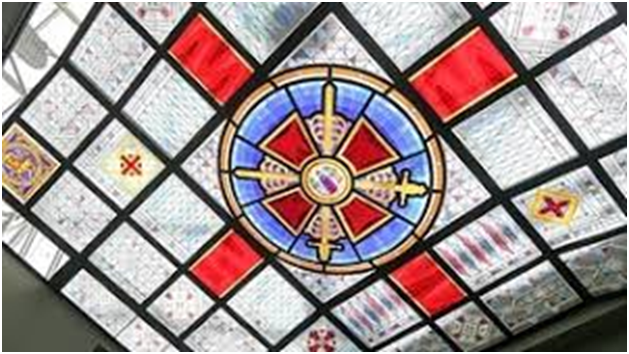Stalin and Putin disappear from Moscow’s Victory Church, but more can be seen (Gallery)
Ceremony marks the end of the construction of the Church of the Russian Armed Forces, dedicated to the Resurrection of Christ. Its inauguration has been postponed until after the COVID-19 pandemic. Stalin's face has been replaced by an inscription praising victory. An icon stands in lieu of Putin’s face. For one observer, the church is an example of “monumental paganism”.
Moscow (AsiaNews) – On Wednesday, the day of the "Half of Pentecost" (25 days after Easter), a thanksgiving moleben was held in the Cathedral of the Resurrection of Christ, i.e. the Great Cathedral of the Armed Forces of the Russian Federation to mark the end of its construction.
The church was supposed to be inaugurated at this time of the year, which coincides with the end of World War Two, but the event was postponed because of the coronavirus outbreak.
Bishop Stephan (Privalov) of Klinsky led the service. He heads the Synodal Department for the pastoral care of the Armed Forces and public security agencies, and is pastor of the patriarchal cathedral. Deputy Defence Ministers General Andrey Kartapolov and General Timur Ivanov took part in the liturgy. At the end of the ceremony, Bishop Stephan thanked army workers, donors and church decorators for their work.
Contrary to expectations, the mosaics representing Joseph Stalin and Vladimir Putin were nowhere to be seen. Evidently, the controversy sparked by their possible inclusion led to their removal. Stalin’s face was no longer in the mosaic dedicated to the victory in the Great Patriotic War (World War Two), on top of a victory banner carried by a crowd. It was replaced by the inscription ‘Raising the Banner of Victory over Berlin,’ made in 1945 by artist Viktor Ivanov.
The images of Putin, Defence Minister Sergey Shoygu, Crimea Governor Sergey Aksyonov and other top officials also disappeared from the image of Crimea’s 2014 annexation. President Putin’s place is now occupied by an icon, and priests are depicted instead of his subordinates. Krym nash! (Crimea is ours!), Putin's shout of exultation on 18 March 2014, the day of the Crimean referendum supervised by the Russian military, which had been included in the image, was replaced by a more neutral My vmeste! (We are together!).
Despite the removals, the head of the Experts’ Council for Church Art, Architecture and Restoration of the Russian Orthodox Church, Protoiyerey (Archpriest) Leonid Kalinin, insisted that the images of Stalin and Putin should have been kept in the church. “It seems to me that notwithstanding the wave of criticism, we see a huge and beautiful church that celebrates the memory of heroes, in honour of the great Victory. This is worth much more than those small fragments of mosaic (compared to the entire volume of the church) that raised so much noise.” For his part, General Kartapolov stressed that "Stalin restored religion in Russia”.
Construction costs have also been a source of controversy. According to Russia’s Defence Ministry, the building cost around six billion rubles (US million), half of which came from Russian “donors;” the other half from the City and Oblast (Province) of Moscow. Father Leonid said that “metal, wood, glass and talent were offered practically free, for a few kopecks. People worked, worked hard for the glory of God.”
Christ and the sword
It is likely that even if the faces of Stalin and Putin have been removed, the decorations will still spark a lot of criticism for the ambiguous mixing of military operations and devotion.
In his blog, Deacon Andrey Kuraev refers to the church as ‘monumental paganism’. In particular, he has a bone to pick with the fresco called "Help of the icon", in which the sacred image of the Mother of God arrives escorted by angels to support the efforts of anti-aircraft artillery.
Another image, called ‘Conquerors of Berlin,’ shows a protective angel on the banner of Victory. Saint Michael the Archangel with spear, head of the celestial and terrestrial hosts, is accompanied by Saint Nicholas with the Gospel and Saint Seraphim with the cross. Some of the depicted saints draw a sword; even a Christ wields one.
No less disturbing are other images involving Calvary, the saints and Our Lady in the wars and triumphs of Russia-Soviet Union. The Mother of God, in full pagan identification with Mother Earth, keeps the fire of heroes in her womb.
On the outside, the church looks like a nuclear missile. Its measurements mark important dates in Russian history. The dome’s diameter is 19.45 metres (reference to the year of victory over Nazism), the bell tower is 75 meters high (like the years since the victory), the lower dome is 14.18 to commemorate 1,418 days of war. For the Soviet Union, which signed a non-aggression pact with Hitler in 1939, the war lasted from 1941 to 1945. Pieces of weapons from the Wehrmacht will be placed on the entrance steps as proposed by Defence Minister Sergey Shoygu.
After construction was completed, videos of a "virtual visit" to the church were released, from which we took pictures for this article.
24/06/2020 09:59
06/08/2021 09:55
10/05/2018 10:23
28/03/2018 17:51




















.png)










